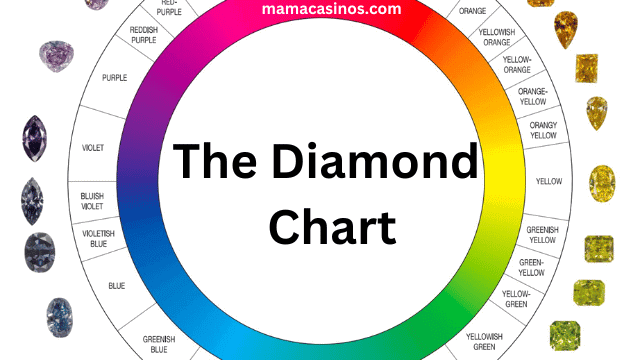Introduction:
Are you looking to buy a diamond but feeling overwhelmed by all the options and technical jargon? Look no further than the Diamond Chart, a comprehensive tool used to evaluate diamond quality. Understanding the Diamond Chart can help you make an informed decision when purchasing a diamond, ensuring you get the best value for your money. In this article, we will break down the Diamond Chart and provide you with all the information you need to make a confident and informed decision.
What is the Diamond Chart?
The Diamond Chart, also known as the Diamond Grading Chart or the Four Cs, is a system used to evaluate the quality of diamonds. The Four Cs stand for Cut, Color, Clarity, and Carat weight, and are used to assess a diamond’s overall quality and value.
How is the Diamond Chart Used?
The Diamond Chart is used by jewelers, diamond graders, and consumers alike to evaluate the quality of a diamond. Each of the Four Cs is assigned a grade or range of grades, which are then combined to provide an overall assessment of the diamond’s quality.
The Four Cs
Cut
The cut of a diamond refers to its proportions, symmetry, and polish, which affect its ability to reflect light and create sparkle. The Diamond Chart assigns a grade of Excellent, Very Good, Good, Fair, or Poor to a diamond’s cut, with Excellent being the highest grade.
Color
The color of a diamond refers to the presence or absence of color, with colorless diamonds being the most valuable. The Diamond Chart assigns a grade of D (colorless) to Z (light yellow) to a diamond’s color, with D being the highest grade.
Clarity
The clarity of a diamond refers to the presence or absence of blemishes or inclusions, which can affect its overall appearance and value. The Diamond Chart assigns a grade of Flawless, Internally Flawless, Very Very Slightly Included, Very Slightly Included, Slightly Included, or Included to a diamond’s clarity, with Flawless being the highest grade.
Carat Weight
The carat weight of a diamond refers to its weight, with one carat equaling 0.2 grams. The Diamond Chart assigns a grade based on the diamond’s weight, with larger diamonds being more valuable.
How to Use the Diamond Chart
Step 1: Determine Your Budget
Before evaluating a diamond’s quality, it’s important to determine your budget. The Diamond Chart can be used to evaluate diamonds of any price range, so it’s important to establish how much you’re willing to spend before beginning your search.
Step 2: Evaluate the Cut
The cut of a diamond is the most important factor in determining its overall appearance and value. Begin by evaluating the cut of the diamond, aiming for a grade of Very Good or higher.
Step 3: Evaluate the Color
After evaluating the cut, move on to the color of the diamond. While colorless diamonds are the most valuable, diamonds with a slight color tint can still be beautiful and valuable.
Step 4: Evaluate the Clarity
Next, evaluate the clarity of the diamond, looking for a diamond with as few blemishes or inclusions as possible.
Step 5: Evaluate the Carat Weight
Finally, evaluate the carat weight of the diamond, keeping in mind that larger diamonds are often more expensive but may not necessarily be of higher quality.
Understanding Diamond Chart Grading Scales
Cut Grading Scale
The Diamond Chart uses a grading scale to rate a diamond’s cut, ranging from Excellent to Poor. The higher the cut grade, the better the diamond’s ability to reflect light and create sparkle. An Excellent cut grade diamond has the highest potential for brightness and fire, while a Poor cut grade diamond will appear dull and lifeless.
Color Grading Scale
The color of a diamond is graded on a scale ranging from D to Z, with D being completely colorless and Z having a visible yellow or brown tint. A diamond’s color can greatly affect its value, with the most valuable diamonds being completely colorless. However, diamonds with a slightly noticeable color tint may still be valuable and can be more affordable than completely colorless diamonds.
Clarity Grading Scale
The clarity of a diamond is graded on a scale ranging from Flawless to Included. A Flawless diamond has no visible inclusions or blemishes, while an Included diamond has many visible inclusions. A diamond’s clarity can greatly affect its appearance and value, with the most valuable diamonds having no visible inclusions or blemishes.
Carat Weight Grading Scale
The carat weight of a diamond is a measure of its weight, with one carat equaling 0.2 grams. The Diamond Chart has a grading scale based on a diamond’s carat weight, with larger diamonds being more valuable. However, it’s important to remember that carat weight should not be the sole fac
tor in determining a diamond’s value and quality.
FAQs
What is the most important factor in determining a diamond’s quality?
The most important factor in determining a diamond’s quality is its cut. A well-cut diamond will reflect light and create sparkle, making it appear more brilliant and valuable.
What is the most valuable color for a diamond?
The most valuable color for a diamond is completely colorless, which is graded as a D on the Diamond Chart. However, slightly colored diamonds can still be valuable and may be more affordable.
Can inclusions or blemishes in a diamond affect its value?
Yes, inclusions or blemishes in a diamond can greatly affect its appearance and value. The most valuable diamonds have no visible inclusions or blemishes, while diamonds with many visible inclusions may be less valuable.
Conclusion
Understanding the Diamond Chart is essential for anyone looking to purchase a diamond. By evaluating a diamond’s Cut, Color, Clarity, and Carat weight, you can make an informed decision and get the best value for your money. Remember to prioritize a well-cut diamond, and keep in mind that completely colorless diamonds are the most valuable but slightly colored diamonds can still be beautiful and valuable. When evaluating a diamond’s clarity, look for as few inclusions or blemishes as possible, and keep in mind that larger diamonds are often more valuable but may not necessarily be of higher quality. By following these guidelines and using the Diamond Chart, you can be confident in your diamond purchase and enjoy its beauty and value for years to come.




